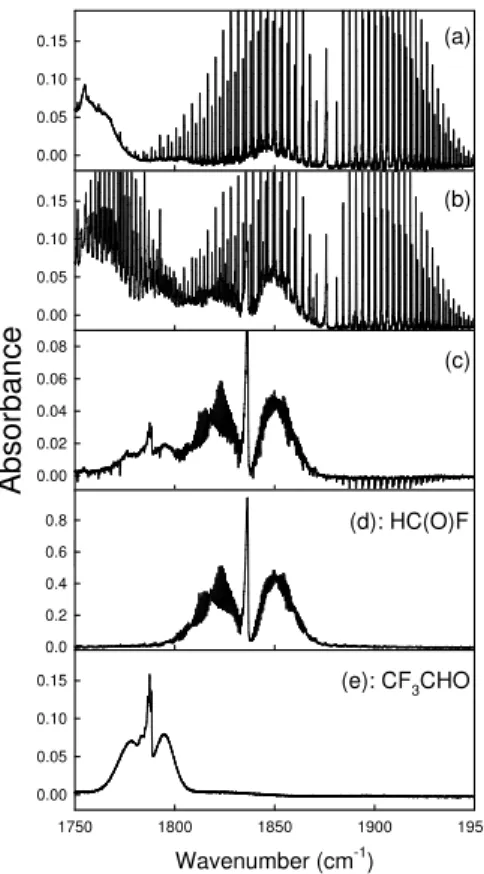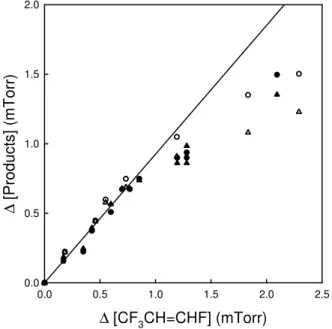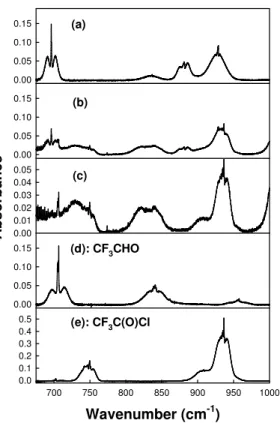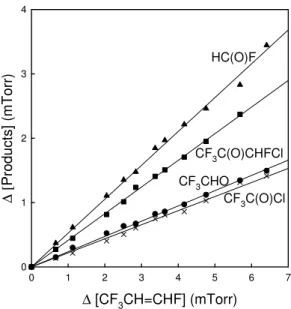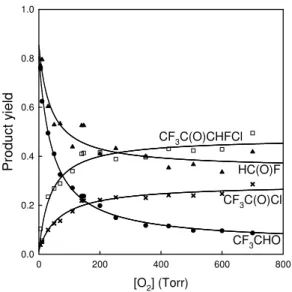HAL Id: hal-00303260
https://hal.archives-ouvertes.fr/hal-00303260
Submitted on 23 Jan 2008HAL is a multi-disciplinary open access
archive for the deposit and dissemination of sci-entific research documents, whether they are pub-lished or not. The documents may come from teaching and research institutions in France or abroad, or from public or private research centers.
L’archive ouverte pluridisciplinaire HAL, est destinée au dépôt et à la diffusion de documents scientifiques de niveau recherche, publiés ou non, émanant des établissements d’enseignement et de recherche français ou étrangers, des laboratoires publics ou privés.
Atmospheric chemistry of trans-CF3CH=CHF: products
and mechanisms of hydroxyl radical and chlorine atom
initiated oxidation
M. S. Javadi, R. Søndergaard, O. J. Nielsen, M. D. Hurley, T. J. Wallington
To cite this version:
M. S. Javadi, R. Søndergaard, O. J. Nielsen, M. D. Hurley, T. J. Wallington. Atmospheric chemistry of trans-CF3CH=CHF: products and mechanisms of hydroxyl radical and chlorine atom initiated oxidation. Atmospheric Chemistry and Physics Discussions, European Geosciences Union, 2008, 8 (1), pp.1069-1088. �hal-00303260�
ACPD
8, 1069–1088, 2008 Atmospheric chemistry of trans-CF3CH=CHF M. S. Javadi et al. Title Page Abstract Introduction Conclusions References Tables Figures ◭ ◮ ◭ ◮ Back CloseFull Screen / Esc
Printer-friendly Version Interactive Discussion
EGU
Atmos. Chem. Phys. Discuss., 8, 1069–1088, 2008 www.atmos-chem-phys-discuss.net/8/1069/2008/ © Author(s) 2008. This work is licensed
under a Creative Commons License.
Atmospheric Chemistry and Physics Discussions
Atmospheric chemistry of
trans-CF
3
CH=CHF: products and
mechanisms of hydroxyl radical and
chlorine atom initiated oxidation
M. S. Javadi1, R. Søndergaard1, O. J. Nielsen1, M. D. Hurley2, and T. J. Wallington2
1
Department of Chemistry, University of Copenhagen, Universitetsparken 5, 2100 Copenhagen, Denmark
2
System Analytics and Environmental Sciences Department, Ford Motor Company, Mail Drop RIC-2122, Dearborn, MI 48121-2053, USA
Received: 4 December 2007 – Accepted: 5 December 2007 – Published: 23 January 2008 Correspondence to: O. J. Nielsen (ojn@kiku.dk)
ACPD
8, 1069–1088, 2008 Atmospheric chemistry of trans-CF3CH=CHF M. S. Javadi et al. Title Page Abstract Introduction Conclusions References Tables Figures ◭ ◮ ◭ ◮ Back CloseFull Screen / Esc
Printer-friendly Version Interactive Discussion
EGU Abstract
Smog chamber/FTIR techniques were used to study the products and mechanisms of OH radical and Cl atom initiated oxidation of trans-CF3CH=CHF in 700 Torr of
N2/O2 diluent at 295±1 K. Hydroxyl radical initiated oxidation leads to the formation of CF3CHO and HC(O)F in yields which were indistinguishable from 100% and were
5
not dependent on the O2 partial pressure. Chlorine atom initiated oxidation gives
HC(O)F, CF3CHO, CF3C(O)Cl, and CF3C(O)CHFCl. The yields of CF3C(O)Cl and CF3C(O)CHFCl increased at the expense of HC(O)F and CF3CHO as the O2 partial
pressure was increased over the range 5–700 Torr. The results are discussed with re-spect to the atmospheric chemistry and environmental impact of trans-CF3CH=CHF.
10
1 Introduction
Recognition of the adverse environmental impact of chlorofluorocarbon (CFC) release into the atmosphere (Molina et al., 1974; Farman et al., 1985) has led to an interna-tional effort to replace these compounds with environmentally acceptable alternatives. Saturated hydrofluorocarbons (HFCs) have become widely used CFC replacements.
15
For example, CF3CH2F (HFC-134a) is used as the working fluid in all modern vehicle air conditioning systems. Hydrofluorocarbons do not contain chlorine and hence do not contribute to the well established chlorine based catalytic ozone destruction cycles (Wallington et al., 1994). The atmospheric lifetime of HFCs is determined by their re-activity towards OH radicals. HFC-134a has a direct global warming potential of 1440
20
over a 100 y time horizon; a factor of 8 lower than the CFC-12 that it replaced (World Meteorological Organization, 2007).
Unsaturated hydrofluorocarbons are a class of compounds, which are potential re-placements for CFCs and saturated HFCs in air conditioning units. In general, un-saturated hydrofluorocarbons react more rapidly with OH radicals, have shorter
at-25
hy-ACPD
8, 1069–1088, 2008 Atmospheric chemistry of trans-CF3CH=CHF M. S. Javadi et al. Title Page Abstract Introduction Conclusions References Tables Figures ◭ ◮ ◭ ◮ Back CloseFull Screen / Esc
Printer-friendly Version Interactive Discussion
EGU
drofluorocarbons. Prior to their large-scale industrial use an assessment of the atmospheric chemistry, and hence environmental impact, of these compounds is needed. The present paper provides information concerning the atmospheric oxi-dation products of trans-CF3CH=CHF. Specifically, smog chamber/FTIR techniques
were used to determine the products of the OH radical and Cl atom initiated
oxi-5
dation of trans-CF3CH=CHF. The present work builds upon a recent kinetic study
in which values of k(Cl+trans-CF3CH=CHF)=(4.64±0.59)×10−11 and
k(OH+trans-CF3CH=CHF)=(9.25±1.72)×10−13cm 3
molecule−1s−1 in 700 Torr total pressure at 296 K were determined (Søndergaard et al., 2007).
2 Experimental
10
Experiments were performed in a 140-liter Pyrex reactor interfaced to a Mattson Sirus 100 FTIR spectrometer (Wallington and Japar, 1989). The reactor was sur-rounded by 22 fluorescent blacklamps (GE F15T8-BL), which were used to photo-chemically initiate the experiments. The products of the atmospheric oxidation of trans-CF3CH=CHF were investigated by irradiating trans-CF3CH=CHF/CH3ONO/O2/N2and
15
trans-CF3CH=CHF/Cl2/O2/N2mixtures. All samples of trans-CF3CH=CHF used in this
work were supplied by Honeywell International Inc. at a purity >99.9% and were used without further purification.
Chlorine atoms were produced by photolysis of molecular chlorine,
Cl2+hv → 2Cl (1)
20
OH radicals were produced by photolysis of CH3ONO in the presence of NO in air,
CH3ONO+hv → CH3O+NO (2)
CH3O+O2→ HO2+ HCHO (3)
ACPD
8, 1069–1088, 2008 Atmospheric chemistry of trans-CF3CH=CHF M. S. Javadi et al. Title Page Abstract Introduction Conclusions References Tables Figures ◭ ◮ ◭ ◮ Back CloseFull Screen / Esc
Printer-friendly Version Interactive Discussion
EGU
CH3ONO was synthesized by the drop wise addition of concentrated sulfuric acid to a saturated solution of NaNO2in methanol. Other reagents were obtained from
commer-cial sources at purities >99%. Experiments were conducted in 700 Torr total pressure of N2/O2, or air diluent at 295±1 K.
Concentrations of reactants and products were monitored by FTIR spectroscopy.
5
IR spectra were derived from 32 coadded interferograms with a spectral resolution of 0.25 cm−1 and an analytical path length of 27.1 m. Unless stated otherwise, quoted uncertainties are two standard deviations from least squares regressions.
3 Results
3.1 Products of OH radical initiated oxidation of trans-CF3CH=CHF
10
To investigate the products and mechanism of the reaction of OH radicals with trans-CF3CH=CHF reaction mixtures consisting of 8.3–34.9 mTorr trans-CF3CH=CHF, 82.3–
117.3 mTorr CH3ONO, 15.1–19.6 mTorr NO, and 126–700 Torr O2in 700 Torr total
pres-sure of N2 diluent were introduced into the chamber and subjected to UV
irradia-tion. Figure 1 shows IR spectra at 1750–1950 cm−1 obtained before (a) and after (b)
15
subjecting a mixture containing 34.9 mTorr trans-CF3CH=CHF, 82.3 mTorr CH3ONO,
19.6 mTorr NO, and 126 Torr O2in 700 Torr of N2diluent to 6 min of UV irradiation. The
consumption of trans-CF3CH=CHF was 6%. Subtraction of IR features attributable to
CF3CH=CHF, H2O, NO, and HCHO (product of CH3ONO photolysis) from panel (b)
gives the product spectrum shown in panel (c). Comparison of the IR features in panel
20
(c) with the reference spectra of HC(O)F and CF3CHO in panels (d) and (e) shows the
formation of these products.
HC(O)F and CF3CHO were the only identified carbon containing products of the OH
radical initiated oxidation of trans-CF3CH=CHF. Figure 2 shows a plot of the observed
formation of HC(O)F and CF3CHO versus loss of trans-CF3CH=CHF. The yields of
25
ACPD
8, 1069–1088, 2008 Atmospheric chemistry of trans-CF3CH=CHF M. S. Javadi et al. Title Page Abstract Introduction Conclusions References Tables Figures ◭ ◮ ◭ ◮ Back CloseFull Screen / Esc
Printer-friendly Version Interactive Discussion
EGU
linear least squares fit to the combined data sets has a slope =0.93±0.08 indistin-guishable from 100%. For consumptions of CF3CH=CHF greater than 1 mTorr the observed yields of HC(O)F and CF3CHO are less than 100% indicating that either
the efficiency of conversion of trans-CF3CH=CHF into HC(O)F and CF3CHO is lower,
or there are significant losses of these products at higher trans-CF3CH=CHF
con-5
versions, or both. To test for heterogeneous loss of HC(O)F and CF3CHO,
reac-tion mixtures were allowed to stand in the dark for 15 min; there was no discernable loss (<2%) of either compound. For the 2–14% conversions of trans-CF3CH=CHF in the data shown in Fig. 2, loss of HC(O)F and CF3CHO via secondary
reac-tions with OH radicals should be of minor importance as their reactivity with OH is
10
less than that of trans-CF3CH=CHF; k(OH+trans-CF3CH=CHF)=(9.25±1.72)×10−13
(Søndergaard et al., 2007), k(OH+HC(O)F)<4×10−15 (Wallington et al., 1993), and
k(OH+CF3CHO)=(6±1.2)×10−13cm3molecule−1s−1 (IUPAC, 2007). It seems likely
that the curvature in Fig. 2 reflects a lower yield of both HC(O)F and CF3CHO with in-creased consumption of CF3CH=CHF. A possible explanation of this effect is the
reac-15
tion of NO2(which increases in concentration with consumption of trans-CF3CH=CHF)
with the alkoxy radicals formed in the system leading to the formation of small amounts of nitrates. In the atmosphere such reactions will not be of any significance and we did not pursue the origin of the curvature further.
By analogy to the well established oxidation mechanism of propene (IUPAC, 2007),
20
the reaction of OH radicals with trans-CF3CH=CHF is expected to proceed via addition
to the >C=C< double bond. The mechanism of the OH radical initiated oxidation of trans-CF3CH=CHF which explains the observed formation of HC(O)F and CF3CHO as
shown in Fig. 3. The results from the present work indicate that irrespective of whether the OH radicals add to the terminal, or central carbon atom, the subsequent reactions
25
ACPD
8, 1069–1088, 2008 Atmospheric chemistry of trans-CF3CH=CHF M. S. Javadi et al. Title Page Abstract Introduction Conclusions References Tables Figures ◭ ◮ ◭ ◮ Back CloseFull Screen / Esc
Printer-friendly Version Interactive Discussion
EGU
3.2 Products of Cl atom initiated oxidation of trans-CF3CH=CHF
The products of the Cl atom initiated oxidation of trans-CF3CH=CHF were studied
using the UV irradiation of trans-CF3CH=CHF/Cl2/O2/N2 mixtures. Mixtures
consist-ing of 6.6–8.4 mTorr trans-CF3CH=CHF, 102.9–134 mTorr Cl2 and 5–700 Torr of O2 in
700 Torr total pressure of N2 diluent were introduced into the reaction chamber and
5
subjected to UV irradiation. Figures 4 and 5 show IR spectra at 675–1000 cm−1 and 1650–2000 cm−1, respectively, obtained before (a) and after (b) subjecting a mixture
containing 6.6 mTorr trans-CF3CH=CHF and 109 mTorr Cl2in 700 Torr air diluent to 20 s
of UV irradiation. Comparison of the IR features formed in low and high [O2]
experi-ments revealed that four products were formed in the chamber; HC(O)F, CF3CHO,
10
CF3C(O)Cl, and a product with a broad absorption feature in the carbonyl stretching
region centered at 1801 cm−1 which we attribute to the ketone CF3C(O)CHFCl. We
do not have a calibrated reference spectrum for CF3C(O)CHFCl. The concentration of this compound in the chamber was estimated by assuming that the carbonyl stretching band integrated absorption cross section at 1780–1820 cm−1 is the same as that in
15
CF3C(O)CH2Cl (1.06×10−17cm molecule−1, Nakayama et al., 2007).
Figure 6 shows a plot of the concentrations of HC(O)F, CF3CHO, CF3C(O)Cl, and
CF3C(O)CHFCl versus the loss of trans-CF3CH=CHF observed following the UV
ir-radiation of a mixture of 6.61 mTorr trans-CF3CH=CHF and 109 mTorr Cl2 in 700 Torr
of air diluent. As seen from Fig. 6 the formation of HC(O)F, CF3C(O)H, CF3C(O)Cl
20
and CF3C(O)CHFCl scaled linearly with the loss of trans-CF3CH=CHF over the range
of trans-CF3CH=CHF consumption of 10–95%. The linearity of the formation of HC(O)F, CF3CHO, CF3C(O)Cl and CF3C(O)CHFCl suggests that loss of these
com-pounds via secondary reactions is not significant. This observation is consistent with the fact that Cl atoms react much more slowly with these products than with the
25
parent trans-CF3CH=CHF compound; k(Cl+trans-CF3CH=CHF)=(4.64±0.59)×10−11
(Søndergaard et al., 2007), k(Cl+HC(O)F)=(1.9±0.2)×10−15 (Meagher et al., 1997), and k(Cl+CF3CHO)=(1.85±0.26)×10−12cm
3
ACPD
8, 1069–1088, 2008 Atmospheric chemistry of trans-CF3CH=CHF M. S. Javadi et al. Title Page Abstract Introduction Conclusions References Tables Figures ◭ ◮ ◭ ◮ Back CloseFull Screen / Esc
Printer-friendly Version Interactive Discussion
EGU
2004). Previous work has shown that CF3C(O)Cl is not lost by heterogeneous pro-cesses, photolysis, or reaction with Cl atoms in the chamber (Møgelberg et al., 1995). As shown in Fig. 7, the yields of HC(O)F, CF3CHO, CF3C(O)Cl and CF3C(O)CHFCl
varied with [O2]. In experiments with high [O2] the yields of CF3C(O)Cl and CF3C(O)CHFCl increased at the expense of HC(O)F and CF3CHO. As in the case
5
of the OH radical attack, the reaction of Cl atoms with trans-CF3CH=CHF is expected
to proceed via electrophilic addition to the terminal and central carbon atoms:
CF3CH=CHF+Cl → CF3CH(•)CHFCl (5a)
→ CF3CHClCHF(•) (5b)
The radicals produced in Reaction (5) will react with O2 to give peroxy radicals which
10
will undergo self- and cross-reaction to give the corresponding alkoxy radicals (in the equations below M represents a third body):
CF3CH(•)CHFCl+O2+M → CF3CH(OO•)CHFCl+M (6a)
CF3CHClCHF(•)+O2+M → CF3CHClCHF(OO•)+M (6b)
CF3CH(OO•)CHFCl+RO2→ CF3CH(O•)CHFCl+RO+O2 (7a)
15
CF3CHClCHF(OO•)+RO2→ CF3CHClCHF(O•)+RO+O2 (7b)
Decomposition via C-C bond scission or reaction with O2are likely fates of the alkoxy
radicals. The observed formation of the ketone CF3C(O)CHFCl in a yield which varies with [O2] shows that CF3C(O•)HCHFCl radicals undergo reaction with O2and
decom-position via C-C bond scission:
20
CF3C(O•)HCHFCl+O2→ CF3C(O)CHFCl+HO2 (8)
ACPD
8, 1069–1088, 2008 Atmospheric chemistry of trans-CF3CH=CHF M. S. Javadi et al. Title Page Abstract Introduction Conclusions References Tables Figures ◭ ◮ ◭ ◮ Back CloseFull Screen / Esc
Printer-friendly Version Interactive Discussion
EGU
The CHFCl(•) radicals formed in Reaction (9) will add O2, undergo reaction with other peroxy radicals in the system to give CHFCl(O•) radicals, and decompose via Cl atom elimination to give HC(O)F (Tuazon et al., 1993). The data in Fig. 7 contain information concerning the rate constant ratio k8/k9. The yield of CF3C(O)CHFCl, YCF3C(O)CHFCl, can be described by the expression YCF3C(O)CHFCl=YCF3CH(O•)CHFCl
5
(k8[O2]/(k8[O2]+k9))+C, where YCF3CH(O•)CHFCl is the yield of CF3CH(O•)CHFCl
rad-icals in the system, k8 and k9 are the rate constants for Reactions (8) and (9), and C is the [O2] independent yield of CF3C(O)CHFCl (e.g., from self-reaction of
CF3CH(OO•)CHFCl peroxy radicals).
The curve through the CF3C(O)CHFCl data in Fig. 7 is a fit of the expression above to
10
the data which gives k8/k9=(8.0±2.6)×10−19cm 3
molecule−1. This value can be com-pared to the analogous rate constant ratio kO2/kdiss=(3.8±1.8)×10−18cm
3
molecule−1 measured for CF3CH(O•)CH2Cl radicals (Nakayama et al., 2007). The increased im-portance of decomposition as an atmospheric fate of CF3CH(O•)CHFCl compared to
CF3CH(O•)CH2Cl radicals is consistent with theoretical work showing that the barrier to
15
C-C bond scission decreases as the degree of fluorine substitution on the two carbon atoms becomes more even and the bond becomes less polar (Somnitz et al., 2001). The limiting value for the CF3C(O)CHFCl yield reached at high [O2] provides a measure
of k5a/(k5a+k5b)=47±7%.
Figure 8 shows the mechanism of Cl atom initiated oxidation of
trans-20
CF3CH=CHF which is consistent with our experimental observations. From
k8/k9=(8.0±2.6)×10−19cm3molecule−1 it can be calculated that in 700 Torr of O 2 the
reaction with O2 accounts for 92% of the CF3CH(O•)CH2Cl radicals with
decomposi-tion accounting for the remaining 8%. Given the estimate of k5a/(k5a+k5b)=47±7%
we then expect a 4% HC(O)F yield resulting from addition of Cl atoms to the
termi-25
nal carbon atom (left hand side of Fig. 8). Hence, we can attribute the bulk of the approximately 40% HC(O)F yield in experiments in 700 Torr of O2 to the
decomposi-tion of CF3CHClCHF(O•) radicals. Decomposition via C-C bond scission is the domi-nant fate of CF3CHClCHFO(•) radicals. Finally, the increase in the yield of CF3C(O)Cl
ACPD
8, 1069–1088, 2008 Atmospheric chemistry of trans-CF3CH=CHF M. S. Javadi et al. Title Page Abstract Introduction Conclusions References Tables Figures ◭ ◮ ◭ ◮ Back CloseFull Screen / Esc
Printer-friendly Version Interactive Discussion
EGU
with [O2] evident in Fig. 7 is consistent with the expected competition between reac-tion with O2 and decomposition for the available CF3CHCl(O•) radicals. The yield of
CF3C(O)Cl, YCF3C(O)Cl, can be described by the expression YCF3C(O)Cl=YCF3CHCl(O•)
(k10[O2]/(k10[O2]+k11))+C, where YCF3CHCl(O•) is the yield of CF3CHCl(O•) radicals in
the system, k10 and k11 are the rate constants for Reactions (10) and (11), and C is
5
the [O2] independent yield of CF3C(O)Cl.
CF3CHCl(O•)+O2→ CF3C(O)Cl+HO2 (10)
CF3CHCl(O•)+M → products (11)
The curve through the CF3C(O)Cl data in Fig. 7 is a fit of the expression above to the
data which gives k10/k11=(4.6±1.9)×10−19cm 3
molecule−1. This result is larger than
10
the previous more direct determination of k10/k11=(2.1±0.4)×10−19cm 3
molecule−1 (Møgelberg et al., 1995). A likely explanation for this discrepancy lies in the indirect and complex route by which CF3CHCl(O•) radicals are formed in the present system. As indicated in Fig. 8, decomposition and reaction with O2 are possible competing fates for CF3CHClCHF(O•) radicals. Increased loss of CF3CHClCHF(O•) via reaction
15
with O2at high [O2] will lead to a decreased yield of CF3CHCl(O•) radicals and hence
CF3C(O)Cl. The net effect will be to cause the CF3C(O)Cl yield to plateau at a lower
[O2] which will lead to an overestimation of k10/k11. To investigate this effect further
would require the use of [O2] levels higher than 700 Torr where a decrease in the yield
of CF3C(O)Cl would be expected with increased loss of CF3CHClCHF(O•) via reaction
20
with O2. Such experiments are beyond the scope of the present work.
4 Atmospheric chemistry and environmental impact of trans-CF3CH=CHF
The present work improves our understanding of the atmospheric chemistry of trans-CF3CH=CHF. The atmospheric lifetime of trans-CF3CH=CHF is dictated by its reaction
with OH radicals (Søndergaard et al., 2007) and has been estimated at approximately 2
ACPD
8, 1069–1088, 2008 Atmospheric chemistry of trans-CF3CH=CHF M. S. Javadi et al. Title Page Abstract Introduction Conclusions References Tables Figures ◭ ◮ ◭ ◮ Back CloseFull Screen / Esc
Printer-friendly Version Interactive Discussion
EGU
weeks. The OH initiated oxidation of trans-CF3CH=CHF gives CF3CHO and HC(O)F in
yields of approximately 100%. CF3CHO is removed from the atmosphere via photolysis
and, to lesser extents, reaction with OH radicals (Chiappero et al., 2006) and addition of water to give the hydrate (Sulbaek Andersen et al., 2006). Photolysis gives CF3and HCO radicals (Chiappero et al., 2006) while reaction with OH gives CF3CO radicals.
5
CF3 radicals will add O2 to give CF3O2 radicals which are then converted into COF2
(Wallington et al., 1994) which hydrolyzes to give CO2 and HF. CF3CO radicals will add O2to give CF3C(O)O2radicals, the majority of which will be converted into COF2,
with a small fraction converted into CF3C(O)OH (Hurley et al., 2006) via reaction with
HO2 radicals. The hydrate, CF3CH(OH)2 is lost via reaction with OH radicals to give
10
CF3C(O)OH (Sulbaek Andersen et al., 2006). The available data suggest that while CF3C(O)OH is not a natural component of the freshwater environment (Nielsen et al.,
2001), it is a natural component of the background oceanic environment (Frank et al., 2002), and any additional burden associated with trans-CF3CH=CHF oxidation will be of negligible environmental significance. We conclude that the products of the
15
atmospheric oxidation of trans-CF3CH=CHF will have negligible environmental impact.
Acknowledgement. M. S. Javadi, R. Søndergaard and O. J. Nielsen acknowledge financial
support from the Danish Natural Science Research Council for the Copenhagen Center for Atmospheric Research (CCAR).
References
20
Chiappero, M. S., Malanca, F. E., Arg ¨uello, G. A., Wooldridge, S. T., Hurley, M. D., Ball, J. C., Wallington, T. J., Waterland, R. L., and Buck, R. C.: Atmospheric chemistry of perfluoroalde-hydes (CxF2x+1CHO) and fluorotelomer aldehydes (CxF2x+1CH2CHO): quantification of the important role of photolysis, J. Phys. Chem. A, 110, 11 944–11 953, 2006.
Farman, J. D., Gardiner, B. G., and Shanklin, J. D.: Large losses of total ozone in Antarctica 25
reveal seasonal ClOx/NOxinteraction, Nature, 315, 207–210, 1985.
Frank, H., Christoph, E. H., Holm-Hansen, O., and Bullister, J. L.: Trifluoroacetate in ocean waters, Environ. Sci. Technol., 36, 12–15, 2002.
ACPD
8, 1069–1088, 2008 Atmospheric chemistry of trans-CF3CH=CHF M. S. Javadi et al. Title Page Abstract Introduction Conclusions References Tables Figures ◭ ◮ ◭ ◮ Back CloseFull Screen / Esc
Printer-friendly Version Interactive Discussion
EGU Hurley, M. D., Ball, J. C., Wallington, T. J., Sulbaek Andersen, M. P., Nielsen, O. J., Ellis, D. A.,
Martin, J. W., and Mabury, S. A.: Atmospheric chemistry of n-CxF2x+1CHO (x=1, 2, 3, 4): fate of n-CxF2x+1C(O) radicals, J. Phys. Chem. A, 110, 12 443–12 447, 2006.
IUPAC, available at:http://www.iupac-kinetic.ch.cam.ac.uk, 2007.
Meagher, R. J., McIntosh, M. E., Hurley, M. D., and Wallington, T. J.: A kinetic study of the 5
reaction of chlorine and fluorine atoms with HC(O)F at 295±2 K, Int. J. Chem. Kinet., 29, 619–625, 1997.
Molina, M. J. and Rowland, F. S.: Stratospheric sink for chlorofluoromethanes: chlorine atom catalysed destruction of ozone, Nature, 249, 810–812, 1974.
Møgelberg, T. E., Nielsen, O. J., Sehested, J., and Wallington, T. J.: Atmospheric chemistry of 10
HCFC-133a: the UV absorption spectra of CF3CClH and CF3CClHO2radicals, reactions of
CF3CClHO2with NO and NO2, and fate of CF3CClHO radicals, J. Phys. Chem., 99, 13 437– 13 444, 1995.
Nakayama, T., Takahashi, K., Matsumi, Y., Sulbaek Andersen, M. P., Nielsen, O. J., Water-land, R. L., Buck, R. C., Hurley, M. D., and Wallington, T. J.: Atmospheric chemistry of 15
CF3CH=CH2and C4F9CH=CH2: products of the gas-phase reactions with Cl atoms and OH radicals, J. Phys. Chem. A, 111, 909–915, 2007.
Nielsen, O. J., Scott, B. F., Spencer, C., Wallington, T. J., and Ball, J. C.: Trifluoroacetic acid in ancient freshwater, Atmos. Environ., 35, 2799–2801, 2001.
Somnitz, H. and Zellner, R.: Theoretical studies of the thermal and chemically activated decom-20
position of CF3CY2O (Y=F, H) radicals, Phys. Chem. Chem. Phys., 3, 2352–2364, 2001.
Sulbaek Andersen, M. P., Nielsen, O. J., Hurley, M. D., Wallington, T. J., Stevens, J. E., Marten, J. W., Ellis, D. A., and Mabury, S. A.: Atmospheric chemistry of n−CxF2x+1CHO (x=1, 3, 4): reaction with Cl atoms, OH radicals and IR spectra of CxF2x+1C(O)O2NO2, J. Phys. Chem. A, 108, 5189–5196, 2004.
25
Sulbaek Andersen, M. P., Toft, A., Nielsen, O. J., Hurley, M. D., Wallington, T. J., Chishima, H., Tonokura, K., Mabury, S. A., Martin, J. W., and Ellis, D. A.: Atmospheric chemistry of perfluorinated aldehyde hydrates (n-CxF2x+1CH(OH)2, x=1, 3, 4): hydration, dehydration, and kinetics and mechanism of Cl atom and OH radical initiated oxidation, J. Phys. Chem. A, 110, 9854–9860, 2006.
30
Søndergaard, R., Nielsen, O. J., Hurley, M. D., Wallington, T. J., and Singh, R.: Atmospheric
chemistry of trans-CF3CH=CHF: kinetics of the gas-phase reactions with Cl atoms, OH
ACPD
8, 1069–1088, 2008 Atmospheric chemistry of trans-CF3CH=CHF M. S. Javadi et al. Title Page Abstract Introduction Conclusions References Tables Figures ◭ ◮ ◭ ◮ Back CloseFull Screen / Esc
Printer-friendly Version Interactive Discussion
EGU Tuazon, E. C. and Atkinson, R.: Tropospheric transformation products of a series of
hydrofluo-rocarbons and hydrochlorofluohydrofluo-rocarbons, J. Atmos. Chem., 17, 179–199, 1993.
Wallington, T. J. and Hurley, M. D.: Atmospheric chemistry of formyl fluoride: reaction with hydroxyl radicals, Environ. Sci. Technol., 27, 1448–1452, 1993.
Wallington, T. J. and Japar, S. M.: Fourier transform infrared kinetic studies of the reaction of 5
HONO with HNO3, NO3and N2O5at 295 K, J. Atmos. Chem., 9, 399–409, 1989.
Wallington, T. J., Schneider, W. F., Worsnop, D. R., Nielsen, O. J., Sehested, J., DeBruyn, W., and Shorter, J. A.: The environmental impact of CFC replacements-HFCs and HCFCs, Environ. Sci. Technol., 28, 320A–326A, 1994.
World Meteorological Organization, Scientific Assessment of Ozone Depletion: 2006, Geneva, 10
ACPD
8, 1069–1088, 2008 Atmospheric chemistry of trans-CF3CH=CHF M. S. Javadi et al. Title Page Abstract Introduction Conclusions References Tables Figures ◭ ◮ ◭ ◮ Back CloseFull Screen / Esc
Printer-friendly Version Interactive Discussion EGU A b s o rb a n c e 0.00 0.02 0.04 0.06 0.08 Wavenumber/ vs 042714rs 0.00 0.05 0.10 0.15 0.00 0.05 0.10 0.15 0.0 0.2 0.4 0.6 0.8 Wavenumber (cm-1) 1750 1800 1850 1900 1950 0.00 0.05 0.10 0.15 (a) (b) (c) (d): HC(O)F (e): CF3CHO
Fig. 1. Infrared spectra acquired before (a) and after (b) UV irradiation of mixtures
34.9 mTorr trans-CF3CH=CHF, 82.3 mTorr CH3ONO, 19.6 mTorr NO and 126 Torr O2in 700 Torr total pressure of N2 diluent. Panel (c) show the residual IR features after subtraction of
fea-tures attributable to trans-CF3CH=CHF, H2O, NO, and HCHO from panel (b). Panels (d) and
ACPD
8, 1069–1088, 2008 Atmospheric chemistry of trans-CF3CH=CHF M. S. Javadi et al. Title Page Abstract Introduction Conclusions References Tables Figures ◭ ◮ ◭ ◮ Back CloseFull Screen / Esc
Printer-friendly Version Interactive Discussion EGU ∆ [CF3CH=CHF] (mTorr) 0.0 0.5 1.0 1.5 2.0 2.5 ∆ [ P ro d u c ts ] (m T o rr ) 0.0 0.5 1.0 1.5 2.0
Fig. 2. Formation of HC(O)F (triangles) and CF3CHO (circles) versus loss of
trans-CF3CH=CHF observed following the UV irradiation of mixtures of 8.32–9.18 mTorr
trans-CF3CH=CHF and 109.1–113.8 mTorr CH3ONO in 700 Torr total pressure of air diluent at
ACPD
8, 1069–1088, 2008 Atmospheric chemistry of trans-CF3CH=CHF M. S. Javadi et al. Title Page Abstract Introduction Conclusions References Tables Figures ◭ ◮ ◭ ◮ Back CloseFull Screen / Esc
Printer-friendly Version Interactive Discussion
EGU
Fig. 3. Mechanism of OH radical initiated oxidation of trans-CF3CH=CHF, boxes indicate
ACPD
8, 1069–1088, 2008 Atmospheric chemistry of trans-CF3CH=CHF M. S. Javadi et al. Title Page Abstract Introduction Conclusions References Tables Figures ◭ ◮ ◭ ◮ Back CloseFull Screen / Esc
Printer-friendly Version Interactive Discussion EGU 0.00 0.01 0.02 0.03 0.04 0.05 0.00 0.05 0.10 0.15 0.00 0.05 0.10 0.15 A b s o rb a n c e 0.00 0.05 0.10 0.15 (a) (b) (d): CF3CHO (c) Wavenumber (cm-1) 700 750 800 850 900 950 1000 0.0 0.1 0.2 0.3 0.4 0.5 (e): CF 3C(O)Cl
Fig. 4. Infrared spectra acquired before (a) and after (b) UV irradiation of 6.6 mTorr
trans-CF3CH=CHF and 109 mTorr Cl2in 700 Torr of air diluent. Panel (c) show the residual IR fea-tures after subtraction of trans-CF3CH=CHF from panel (b). Panels (d) and (e) show reference spectra of CF3CHO and CF3C(O)Cl, respectively.
ACPD
8, 1069–1088, 2008 Atmospheric chemistry of trans-CF3CH=CHF M. S. Javadi et al. Title Page Abstract Introduction Conclusions References Tables Figures ◭ ◮ ◭ ◮ Back CloseFull Screen / Esc
Printer-friendly Version Interactive Discussion EGU Wavenumber (cm-1) 1700 1800 1900 2000 A b s o rb a n c e 0.00 0.05 0.10 0.15 2D Graph 3 0.00 0.02 0.04 0.06 0.00 0.05 0.10 0.15 0.0 0.1 0.2 0.3 0.0 0.2 0.4 0.6 0.8 (a) (b) (d) (c): HC(O)F (e): CF3CHO
Fig. 5. Infrared spectra acquired before (a) and after (b) UV irradiation of 6.6 mTorr
trans-CF3CH=CHF and 109 mTorr Cl2in 700 Torr of air diluent. Panel (c) show a reference spectrum of HC(O)F. Panel (d) show the residual IR features after subtraction of trans-CF3CH=CHF and
ACPD
8, 1069–1088, 2008 Atmospheric chemistry of trans-CF3CH=CHF M. S. Javadi et al. Title Page Abstract Introduction Conclusions References Tables Figures ◭ ◮ ◭ ◮ Back CloseFull Screen / Esc
Printer-friendly Version Interactive Discussion EGU ∆ [CF3CH=CHF] (mTorr) 0 1 2 3 4 5 6 7 ∆ [ P ro d u c ts ] (m T o rr ) 0 1 2 3 4 HC(O)F CF3C(O)CHFCl CF3CHO CF3C(O)Cl
Fig. 6. Formation of HC(O)F (triangles), CF3C(O)CHFCl (squares), CF3CHO (circles) and,
CF3C(O)Cl (crosses) versus loss of trans-CF3CH=CHF observed following the UV irradiation
ACPD
8, 1069–1088, 2008 Atmospheric chemistry of trans-CF3CH=CHF M. S. Javadi et al. Title Page Abstract Introduction Conclusions References Tables Figures ◭ ◮ ◭ ◮ Back CloseFull Screen / Esc
Printer-friendly Version Interactive Discussion EGU [O2] (Torr) 0 200 400 600 800 P ro d u c t y ie ld 0.0 0.2 0.4 0.6 0.8 1.0 HC(O)F CF3CHO CF3C(O)Cl CF3C(O)CHFCl
Fig. 7. Observed molar yields of HC(O)F (triangles), CF3CHO (circles), CF3C(O)Cl (crosses)
and CF3C(O)CHFCl (squares) versus the O2 partial pressure following the UV irradiation
of trans-CF3CH=CHF/Cl2/N2/O2 mixtures at 700 Torr total pressure. Curves through the
CF3C(O)CHFCl and CF3C(O)Cl are fits to the data using the expressions described in the text. The curves through the HC(O)F and CF3CHO data are polynominal fits to aid visual inspection of data trends.
ACPD
8, 1069–1088, 2008 Atmospheric chemistry of trans-CF3CH=CHF M. S. Javadi et al. Title Page Abstract Introduction Conclusions References Tables Figures ◭ ◮ ◭ ◮ Back CloseFull Screen / Esc
Printer-friendly Version Interactive Discussion
EGU
Fig. 8. Mechanism of Cl atom initiated oxidation of trans-CF3CH=CHF, boxes indicate observed
